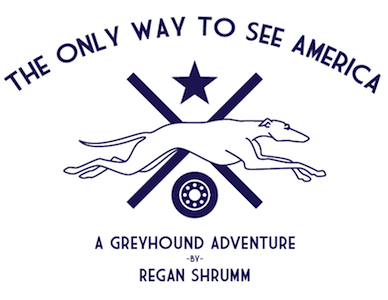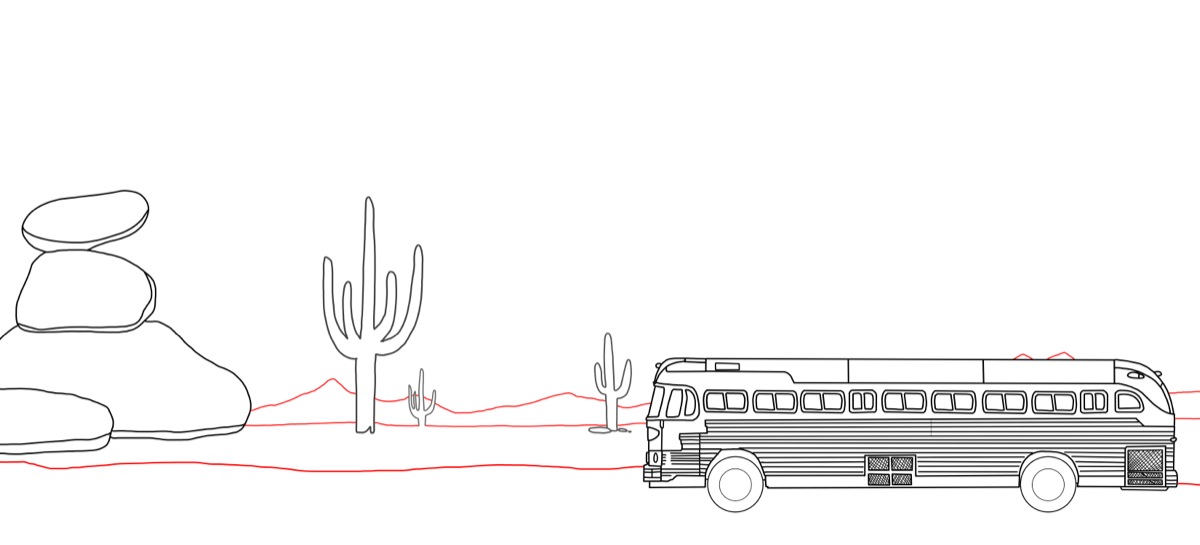
“See America By Bus…The Modern Way!” This giant sign, located in a 1940s art deco Greyhound station in downtown Olympia, Washington, struck me as soon as I saw it. Was this sign trying to be ironic with its motto, trying to usher a new wave of hipster bus travellers, or was it so old that commercial airlines hadn’t even been invented yet? Either way, this sign symbolized the romantically bleak nostalgia which came with my Greyhound trip across the west coast of America.
Dirty Danger
Many thought I was crazy for travellers from Victoria to Riverside, California, about two hours north of the Mexican border. The 56-hour ride would eventually take me to my ultimate destination, where I would talk at two academic conferences, and then ride back within the same week. My parents and friends were worried and tried to persuade me to take a plane so I would be more comfortable. Maybe it was the fact that I had never travelled alone and craved a Kerouac-induced experience of California; maybe it was due to my binge listening of This American Life podcasts which made me homesick for the country I once live in; or maybe it was the fact that I would save over $300 on the trip, but in the end, I decided the long trip was for me.
“I’ll just read and enjoy the scenery,” I told my well-Greyhound-traveled friend. “Plus, the people taking the Greyhound can’t be worse than any other public bus.”
“The difference between the regular bus and the Greyhound,” she explained, “is that on the Greyhound, everyone — including the driver — is a convicted felon.”
[pullquote]Hell, I had even seen a person get stabbed in the Kamloops Greyhound station years before I started my arduous journey[/pullquote]
I admit that Greyhound has had problems in the past. The most famous incident occurred in 2008, when a 22-year-old carnival worker was stabbed, beheaded, and cannibalized while riding a bus from Alberta to Manitoba. As recently as January of this year, a Greyhound bus crashed near the Arizona-California border after a 25-year-old tried to take over the vehicle, leaving several injured. Hell, I had even seen a person get stabbed in the Kamloops Greyhound station years before I started my arduous journey.
The Greyhound company, first named the Mesaba Transportation Company, began in 1914 when founder Carl Eric Wickman began transporting miners in his seven-passenger car from the iron ore mine to Hibbing, Minnesota for 15 cents. Many of these miners went into town not to their families, but to enjoy the alcohol and female escorts. These trips were years before the first buses were manufactured in 1921, when all of these vehicles were dubbed “greyhounds” for their sleek appearance and grey colour. After buying and selling several different bus companies, Wickman finally named his company Greyhound Corporation in 1929, during the start of the Great Depression. To survive the Depression, Greyhound joined forces with the Great Northern Railroad, offering low prices and both modes of transportation, as a means to combat the now-affordable Model T. In the late 1950s and 1960s, Greyhound offered a special unlimited mileage package of “99 days for 99 dollars.” Even today, the average Greyhound passenger pays $52 to travel about 355 miles.
When I started my bus adventure, I quickly learned the rules of the road. Every bus smells of a mixture of septic tank fumes, body odour, and an orange-scented spray that is supposed to cover the aforementioned odours. Just like a high school classroom, the rowdy people sit in the back of the bus, as if compelled to squat near the bathroom. Most importantly, always leave your luggage in line at the door for your next bus and leave the station. For some reason, there is an unspoken decree that no one will take the items, even at the most dingy of stations, since everyone already left the station to avoid the stained carpet, flickering lighting, and smell of piss. This may seem contrary to Greyhound’s reputation, but I feel like this strange event occurs because camaraderie transpires from onerous situations, especially those involving the smell of bodily fluids.
Everyday People
“Melinda, this is Daisy. Chris is dead! Yes, my husband is dead!”
Heading from Seattle to Portland, I sat next to an ordinary looking woman—her smile was pleasant and silently encouraged me to sit beside her. After some small talk, the conversation stopped, allowing me to continue reading and her to use her phone, sobbing as she started dialing numbers. I rudely listened in on the conversation, remembering to turn the page every few minutes to demonstrate that I was indeed “reading,” but the woman’s crying became louder as she shouted, “He’s dead! He’s dead!”
Finally, after finishing her call, I turned to the woman and asked her if there was any way I could help. Her eyes started to dry, though evidence of the salty wetness continued to run down her cheeks.
“No, that’s fine. My husband isn’t really dead.”
[pullquote]I also had discussions with people who were just trying to get by, people who had misfortunes in one town and raised enough money to buy a one-way ticket to as far as they could afford.[/pullquote]
I turned away, as the woman began to phone another number, again blaring: “Elizabeth, this is Daisy. Chris is dead!”
As I heard the same story over and over again, I wondered why this woman would come up with such a big lie. Was she just trying to get another week’s worth of vacation? Had this Chris joined a witness protection program so his wife had to phone all of his old Mafia contacts? Personally, I prefer to believe that this woman was contacting all of her family members ahead of time as she travelled down to Portland, where ultimately Chris would die by her hands — a modern-day femme fatale.
Every day I was faced with bizarre occurrences. I think back to the time when two strangers met for the first time across the aisle from me. After realizing that they were related to one another, the pair proceeded to talk until the early morning, only to end the conversation with a lewd act on the bus that would make most blush. It was indeed a “happy ending” for all, as I sneaked a peek to make sure my ears weren’t deceiving me. Happy except for those, like me, who were left sleepless from their mutual moaning. The pair later parted ways with a kiss and a butt slap, but no phone number for future incestuous fun.
But I also had discussions with people who were just trying to get by, people who had misfortunes in one town and raised enough money to buy a one-way ticket to as far as they could afford. Others were travelling to see their daughter and new grandchild, but could not afford a plane ride. Another traveller was leaving secret love notes for her boyfriend to find at each station, as he would be passing down the same route a week later.
The Bleak American Dream
Although there was hope in some people’s lives, the Greyhound eventually became a symbol of a bleak American Dream. My bus travelled all the way down the Interstate 5, stopping in major cities and small towns along the route. We passed by hundreds of boarded-up towns, with only gun ammo/fish tackle convenience stores, under-sized casinos, and once-glistening Greyhound stations remaining. Meanwhile, big-boxed villages with shops serving all-your-24-hour-liquor-pharmaceutical-and-gun needs filled their asphalt parking lots with SUVs and empty beer cans.
Though I had lived in America for most of my life, I had never gotten such a big taste of it until I saw the 24-hour Subway/Mexican restaurant/massage parlour/arcade/convenience store just three hours north of Los Angeles. The Goliath of a shop’s flashing neon lights and circus smells became nauseating in a sensory overload. There wasn’t a blank space in the building, with most nooks being filled with a vending machine or photo booth. Electronic beeps came from one of many cashiers’ scanners as customers took advantage of the 4-for-$3 Krispy Kreme deal. Fluorescent lights seemed to flicker to the beat of the K-pop music blasting on the speakers, while Zoltar, the automated fortune teller, demanded to know what I wished for. “I want to get out of here,” I muttered, as I thought “to be big” was not the most fitting response.
Everyone had the same routine: rushing in line to consume food, then waiting in line to purge their food in the bathroom, before finally heading back to the bus to wait until they were taken to the next stop. The crowd turned into a kind of herd, simply trying to follow routine. Outside this chaotic setting, a surreal environment of pure desert hills jumbled with a crooked highway as a mystic air rose off from the cars.
[pullquote]In 1943, Greyhound wanted to tailor to the rich by integrating air and bus service with a flying bus-helicopter, but sadly, they never did.[/pullquote]
These convenience stores have actually been connected to Greyhound for most of the company’s days. In the 1940s, Greyhound became the first bus company to launch a national chain of restaurants called the Post House. Fancier than greasy roadside diners, the Post House offered non-greasy diner food at each location, though even non-dining Greyhound customers could enjoy a glass of milk on the house. While Post Houses are now no more, during the 1960s, when Greyhound was in financial trouble, the company started buying other businesses to stabilize itself, including Burger King, Dial Soap, and a package delivery service. The latter industry is the only one Greyhound still owns today.
Restaurants weren’t the only target of their upscale aspirations. Greyhound was featured in the 1934 Academy Award winner, It Happened One Night, where a couple (played by Clark Gable and Claudette Colbert) travelled across America on a bus. After the film, the two stars and other Hollywood elite starred in magazine and radio ads, emphasizing the luxury of having someone else at the wheel. In 1943, Greyhound wanted to tailor their clientele to the rich by working with the Civil Aeronautics Board (CAB) to create an integration of air and bus service — basically a flying bus-helicopter. Unfortunately, this amazing plan will only live on in my dreams, as the CAB could never develop a commercial helicopter.
Yet, I can still see some of that luxury as I pull into the Olympia Greyhound station. The silver overhang and neon lights suggest a diner, but the big attached terminal tells me otherwise. The bus driver shouts his five minute warning, as the passengers scramble off to take a smoke break and move their legs. Too short a time to walk around the town, I jaunt down a block to see fairy lights twinkling inside a pizzeria and a couple holding hands as they whisper sweet nothings to each other, with only the sound of crickets in the air. Looking back down the street, the station’s sign – BUS – draws my eyes to the building like a moth to a flame. I forget my current city and century, for it could be Anyplace, USA. But the bus horn helps me remember as I run back to my transportation Romeo, carrying me to my next destination, just past the sunset.









